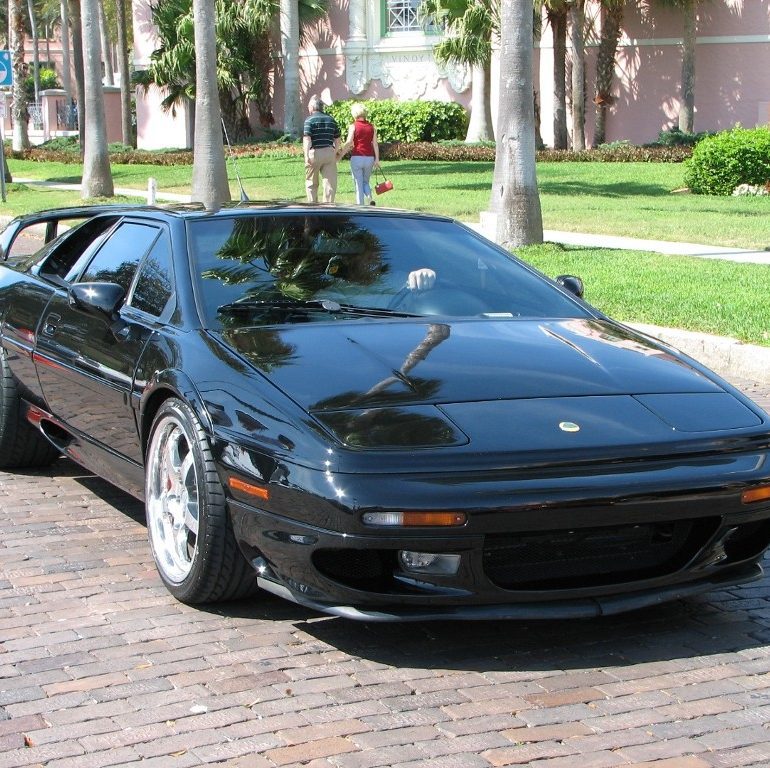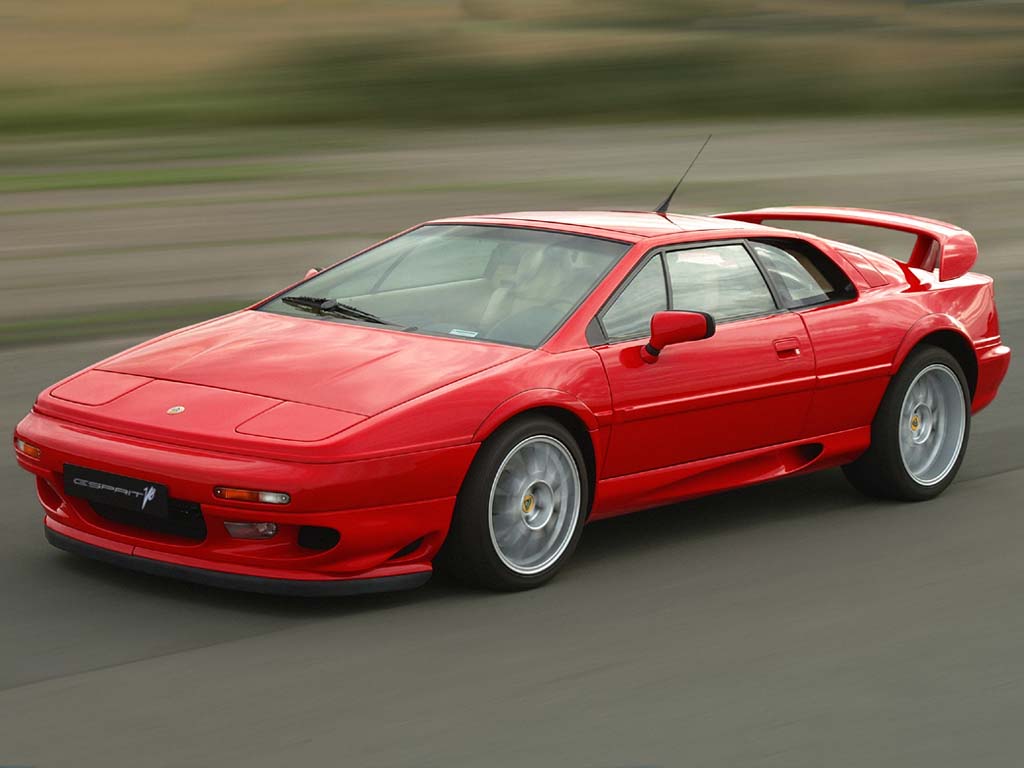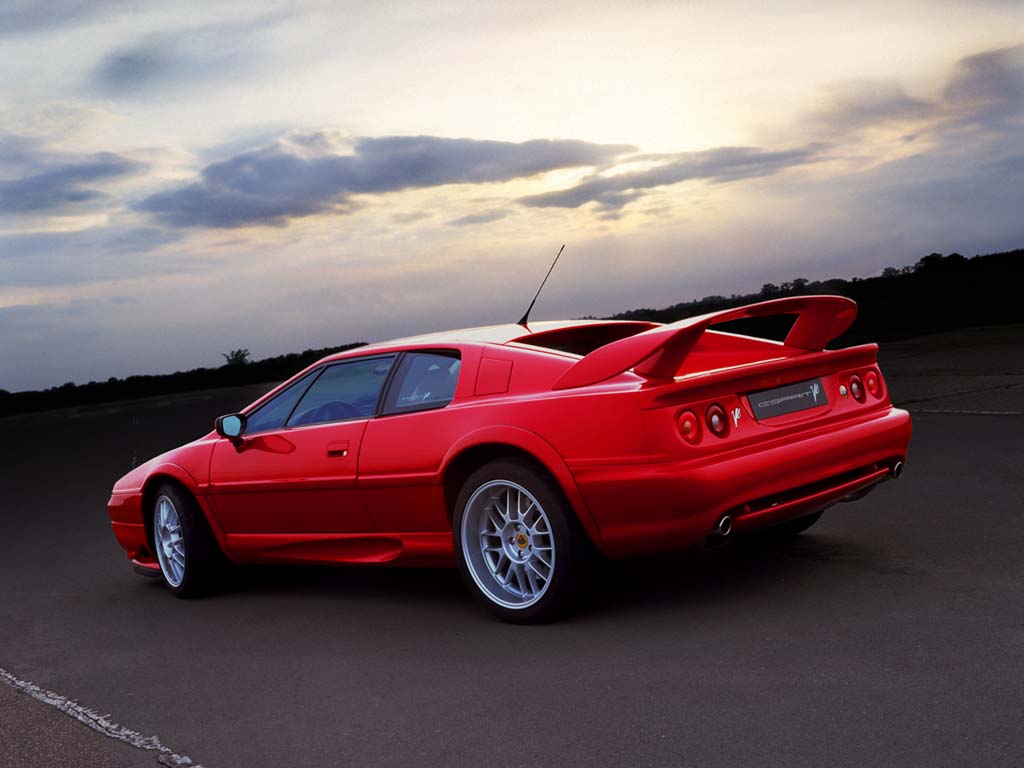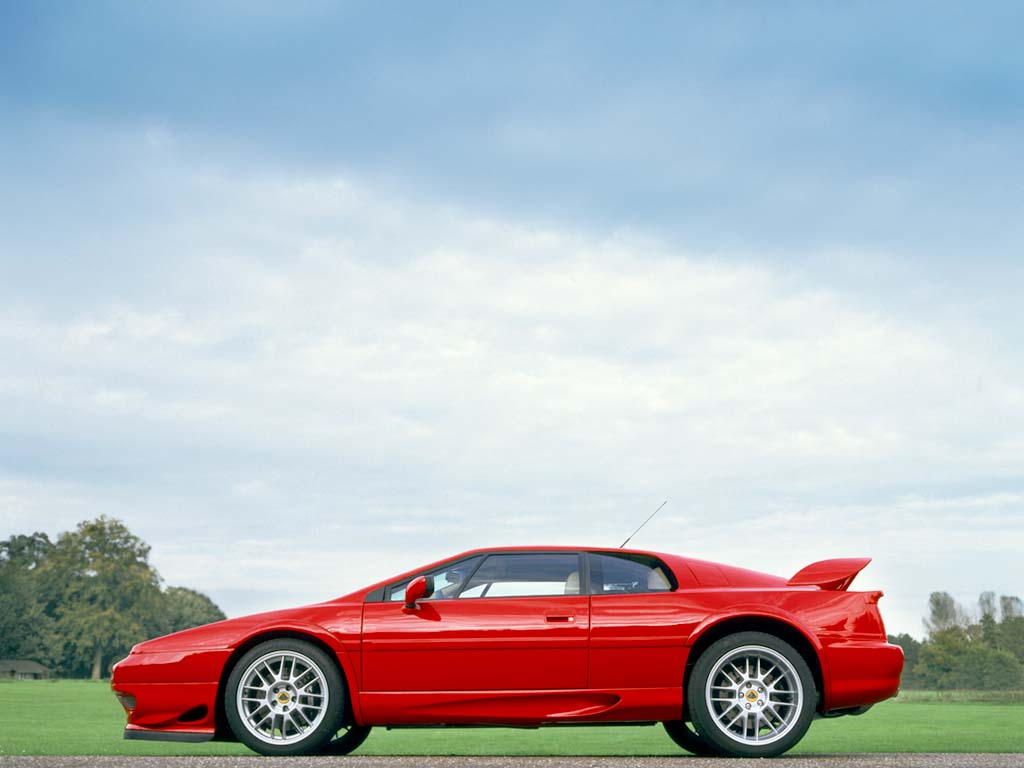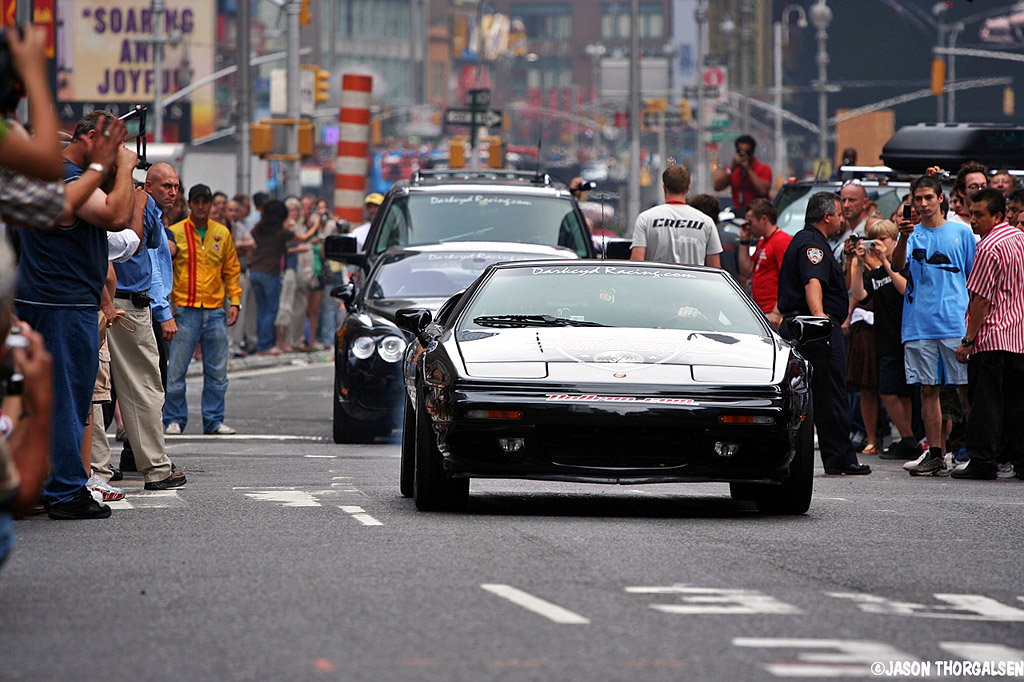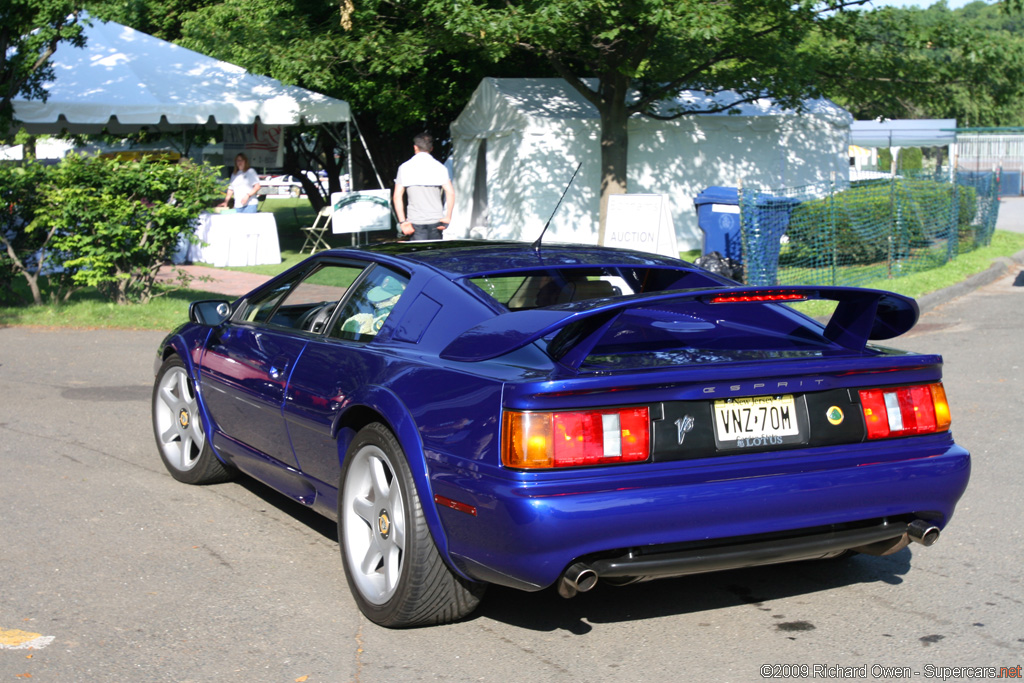2002 Lotus Esprit V8
Years: 2002-2004
Names: 02 / 2002 / Type 85
Units: 292
Engine: 3,500 cc turbo V8
Power: 349 bhp @ 6,500 rpm
Torque: 295 lb/ft @ 4,250 rpm
0-60 mph: 4.7 seconds
To celebrate 30 years of this performance car, Lotus has given the Esprit a facelift. The redesigned rear panel and light cluster carry over some of the Elise design elements. The front got the lip spoiler from the Sport 350.
In 2002, the Lotus Esprit reaches a milestone in its illustrious history. Unveiled in 1972 as a styling concept at the Turin Motor Show, the Esprit entered production in the mid 1970s and today is accepted as being one of the world’s finest supercars. To celebrate 30 years of this performance car, Lotus has given the Esprit a facelift.
The redesigned rear panel and light cluster, which features round rear lights set in pairs, carry over some of the Elise design elements. The front of the Esprit has inherited the lip spoiler from the legendary Sport 350 ensuring greater stability at very high speeds.
Many subtle changes can also be seen in the interior too. The new high backed seats featuring an embossed Lotus logo are available in two tone leather and are a no cost option. A distinct aluminium theme features throughout the interior providing an elegant, technological, lightweight finish to the gear lever, handbrake sleeve, inner door panel and new inner door sill which also features the Lotus logo.
The new “crystal titanium” finish multi spoke OZ Racing alloy wheels hide powerful 4-pot calipers with an advanced Kelsey Hayes ABS system. Large 320mm diameter AP Racing two piece brake discs are vented and cross-drilled, front and rear, for maximum cooling and heat dissipation when the car is subjected to sustained heavy braking. The race specification calipers, pads and discs ensure that the Esprit stops as well as it goes.
The Esprit V8 is powered by the Lotus designed 3.5 litre twin turbocharged V8 engine producing 350 hp at 6,500 rpm with racing versions currently producing over 550 hp with very few changes from the standard road engine! The product of thoughtful design, the engine is efficient, compact and lightweight (weighing less than 220 kg complete with all ancillaries). A wide torque band with peak of 400 Nm (295 ft.lb.) at 4,250 rpm assures an incredibly smooth power delivery and an effortless but rapid acceleration in all five gears.
For many, the Esprit is a car of both memories and dreams. From being James Bond’s versatile high performance transport in the 1970s and 1980s to maintaining the crown of Britain’s great supercar, the Esprit is really in an unstoppable class of its own.
The End of the Esprit – The Final Run
Lotus sold the Esprit in the USA market for several years by means of government waivers that allowed it to bypass some of the stringent federal regulations implemented in recent years. Every year, these regulations get tougher and waivers are harder to get approved. Lotus decided to cease production of the Esprit after more than 27 years. Production ended in December 2003 for USA market cars while other markets finished earlier in the year.
The last 95 (unconfirmed) Esprits of the production line headed to the United States. The final run have had a few modifications made to them and were known as the “Esprit Final Run Edition”. In all states except California, this car was be labeled as a 2004MY. In California, the car was sold as a 2003½MY car. This was done to avoid some of the more stringent environmental regulations which went into effect for that state for 2004 and newer cars. These regulations would have involved further development of the ECM software code at a great expense to Lotus. Since this was the last year of production, it was decided it would be more sensible to simply refer to those cars as 2003½ cars instead. In terms of upgrades this model had Bilstein Dampers with stiffened settings and adjustable spring platforms and uprated Eibach springs. There were also some other cosmetic updates too. The car was priced at US$95,000.
Pictures
Specs
| submitted by | Richard Owen |
| price $ | $71 000 USD |
| engine | V8 |
| position | Mid Engine |
| aspiration | Twin Turbo |
| valvetrain | DOHC 4 Valves / Cyl |
| displacement | 3500 cc / 213.6 in³ |
| bore | 83 mm / 3.27 in |
| stroke | 81 mm / 3.19 in |
| power | 261.0 kw / 350 bhp @ 6500 rpm |
| specific output | 100.0 bhp per litre |
| bhp/weight | bhp per tonne |
| torque | 399.97 nm / 295.0 ft lbs @ 4250 rpm |
| body / frame | Composite Fibre |
| driven wheels | RWD |
| front brakes | AP Racing Vented & Cross Drilled Discs w/ABS & 4-Pot Calipers |
| f brake size | x 320 mm / x 12.6 in |
| rear brakes | AP Racing Vented & Cross Drilled Discs w/ABS & 4-Pot Calipers |
| r brake size | x 320 mm / x 12.6 in |
| transmission | 5-Speed Manual |
| gear ratios | 3.36:1, 2.06:1, 1.38:1, 1.04:1, 0.82:1, :1 |
| final drive | 3.89:1 |
Performance
| Top Speed | 175 mph |
| 0-60 mph | 4.8s |
| 0-100 km/h | 4.9s |
| 0-100 mph | 10.5s |
| 0-160 km/h | 10.3s |
Videos
Lotus Esprit Final Edition Review
Autocar December 2001 – What They Said
NO CHANGE OF HEART
Lotus’s classic Esprit may have had a facelift, but underneath it’s still the same as it always was — a blindingly quick, adrenalin-pumping supercar
As gestation periods go, the four year it took Colin Chapman to finally get an Esprit on the road after its first public showing in 1972 was a touch on the lengthy side, to say the least. Didn’t bode well, either. Historically, British sports cars that are reluctant to take on a self-propelling, three-dimensional and, most crucial of all, a purchasable form, are not destined for great things: I give you the Panther Solo and Strathcarron SC-5A as masters of the trade.
Odd, then, that the funny little plastic coupe from Norfolk whose shape was cunningly inspired by a wedge of gouda cheese — the car that took 007 swimming and skiing — has been on sale continuously since 1976. Good news, too, because it means there has long been another supercar out there to keep the Aston company — for those patriotic enough to care about such things — wrapped in a Union Jack and generally adored. The Esprit is ours.
Time and circumstances have been kind to Esprit. It exists in the world where a decade is considered a short production life; a place where the supreme expression of this type of vehicle, the Porsche 911, has had the same basic shape and mechanical layout for 37 years. Next time someone points out just how grey the Esprit is getting, remind them that the Porsche had 12 candles on its birthday cake the year the Lotus was born. Nevertheless, age is a measure of experience, and the Esprit has done time, and plenty of it.
And it’s likely to be with us for a while yet, because Lotus has decided to carry on building the thing. That’s not quite the brave upstanding decision it sounds, either. To be honest, the car sells in tiny volumes in this country, but US sales are healthier. And if you’ve got the tooling, know each car makes money and want a supercar on the company notepaper for brand reasons, it makes perfect sense.
There are less tangible reasons, too. Chapman wouldn’t recognize his cosy little Hethel facility in it Y2K plus one specification. It’s a big place now, churning out Elises and Vauxhall VX220s. But no one at the company has forgotten the initials on that yellow and green badge.
In line with Chapman’s engineering and work ethic, the sports cars are still light, bodywork is still plastic and Friday remains a half day. But the one remaining, wholly physical link with Lotus circa 2001 and the guv’nor himself is the Esprit. That alone should be a reason for knocking them out at a glacial rate.
Press literature concerning the alterations to the new Esprit isn’t extensive. It doesn’t have to be. Five words suffice: new rear lights, new wheels. As overhauls go, it won’t be remembered alongside the great automotive transformations, but getting stuck in a four-hour snarl-up on the A11 en route to Hethel gives us time to remind ourselves why the Esprit’s dynamics have always been held in high regard. For the record, by the way, those new light clusters look pleasantly reminiscent of Ferrari, and the latest OZ wheels are pretty easy on the eye as well.
But let’s give credit where it’s really due. Take a shufty through the spec sheet and you quickly realise that only the most twisted power junkies would want to meddle with the Esprit’s gizzards. This supposedly geriatric two-seater still has a tidy 358bhp at 6500rpm and 295lb ft of torque at 4250rpm: enough welt to deal with just about anything on the planet and, given the twin-turbo-induced flat-torque curve, available all the time.
The rest is as before: steel backbone chassis with frames for the front and rear double-wishbone suspension. Seems rather a quaint layout at a time when the Elise gets full aluminum and industrial Pritt Stick treatment.
But chassis configuration is currently the last thing on my mind, because today’s first discipline is some fast lap work. And from where I’m sitting it feels like the track’s covered in oil — not the ideal surface on which to reacquaint oneself with a 350bhp mid-engined supercar. This is my first steer in an Esprit around Lotus’s own circuit and despite knowing the place reasonably well, wet or dry, I’m struggling.
Struggling to get the thing out of second gear bends without spinning the inside rear-wheel and slapping the rev-limiter; struggling with how little grip the Dunlops seem to offer in these conditions. Wondering, between you and me, why on earth Lotus wants to keep on building the thing. Two laps down and it feels old enough for a day-in-the-life-of billing on Walking with Beasts.
Peeling off, come back in, smile at the Lotus boys when they ask me what I think and get a cup of char down my neck. Fast. Because my mind’s a whirl of negativity: the car feels ancient the moment you open the door. Comfy, supportive chair, mad flat-pane of glass for a windshield and a splattering of switchgear that Peugeot deemed decrepit enough to ditch with the 306. The gearbox is close to shambolic, and the throttle pedal’s set so high Geri Halliwell could only just about articulate the old heel’n’toe with her rudest pair of platforms. Yikes.
Get it rolling; still nothing like enough noise from the flat-plane V8, but is certainly goes hard enough. God, there’s that ruddy gearchange again, but on thing’s starting to shine through: the steering. Assisted racks don’t come much better than this for the simple reason that it doesn’t fell hydraulically aided in any way. It’s fast, fingertip accurate, and a real pleasure. Need to try it again.
Nose out slowly, one to three: short shift to fourth. Move the car around on the straight a bit just to confirm how reassuring the rack is. Building speed into the lap now, later on the gas coming out of bends, allowing the tyres a smidge more time to cope with the torque reaction and the old boy’s starting to work. Three more laps like this then — taking advantage of the torque rather than cursing it as an incendiary demolisher of unsuspecting Dunlops. Still, the Esprit deserves a limited-slip diff and not the open one that hastens such single-tyre executions.
Two things learnt, then: first, how unaccustomed we’ve become to a rear-drive chassis with massive power but without traction control. In the dry this thing’ll easily liquorice your asphalt; just how I though it’d take the full monty in the damp I’ll never know. The second is more pertinent; profuse thanks to my commonsense, not to say courteous, instincts for keeping me quiet when the Lotus lads asked me what I thought. Could have gone off a little too half-cocked at this point. As I’ve already implied, this car couldn’t have survived for so long on mindless muscle alone.
More tea, then. Beyond the steering, it’s the Esprit’s composure that impresses most. In Lotus speak it ‘breathes’ with the road surface, doing its very best to deal with surface imperfections rather than just skip over them. Supple’s the word.
As is quick. And massively. I’ve been as guilty as anyone of late of telling the world that the SubaBishi rally-nutter revolution has all but killed the supercar. Well, one sustained wallop of third-gear action in the Esprit is enough to shut me up. No, you can’t use it often and, no it’s not nearly as fast cross-country, but it sure has the car-nutter gland secreting a huge dose of adrenalin.
However, the Esprit is the purveyor of a much blacker magic than anything its chassis can offer. It’s an experience. It may not have anything like the emotional magnetism of a Ferrari, but it deserves to be categorized alongside such cars for what it offers. The Ministry of Sound would package the Esprit as ‘Old School’, celebrate its oddities and its age. From my seat it’s not that easy — a 911 is similar money, just as fast and far better dynamically. And it’s an experience, too.
But even the Porsche doesn’t pass the ultimate supercar test as well as the Lotus. Take one Esprit, one suburban road, preferably near a school, and cruise at 15mph. Add 10 kids and watch them go berserk. It’s a car capable of making grown men fall over just pointing at it. And that’s just cool.
THEY KNOW IT’S A RELIC, But the Lotus Esprit genuinely defines the difference between a product that deserves to live in small volumes, and one that really should crawl under a rock and die — because despite its age, the old lad is a surprisingly appealing car. Lotus is under no illusion that the Esprit has what it takes to claw market share from Porsche, but because its dynamics in no way detract from the brand, it’s happy to keep building the cars.
And then you do something foolish, like ask Lotus to justify why they’d bother to do such a thing. And, as is always the case with Lotus (and hopefully always will be), they don’t just wheel a PR face out to spout market garbage. They provide one smiley engineer and a bucket full of data.
Data that illustrates how different the car is from any other current Lotus product. And that reminds you just how fast the thing is. Standing start acceleration has long been an Esprit A-grade subject, and this latest version is no different. Not much can live with 0-60mph in 4.8sec and 0-100mph in 10.5sec. And it’s beyond three figures that it’ll prove most damaging to an Evo VII’s ego.
And so to their beloved circuit, a place that illustrates the positive and negative aspects of real supercar performance. Considering Hethel has a straight long enough for the Esprit to hit 144mph, it’s amazing that the Elise is only 2.2sec slower over a lap, since it can manage only 122mph at the same point. Much of the difference is down to the Elise’s lighter kerb weight and greater agility, but modern chassis design means Lotus boys have allowed the Elise to use its tyres far more efficiently.
But then they put the paperwork away, look at the Esprit parked among hundreds of Elises, and smile. Start talking like car nuts; gesturing with armfuls of opposite lock, telling me it’s a shot in the arm, almost insanely fast and a real fix when you’re in the mood. That’s the thing about the Esprit: it’s a car that’s easily supported by objective data, even if it hasn’t benefited from the chassis revolution that’s happened at Lotus post-Elise. We won’t see a new product for a long time; maybe never. Best enjoy Norfolk’s only supercar while it’s around.
AutoExpress November 2001 – What They Said
New Esprit: End of the Legend?
AutoExpress, November 2001
by Martin Sharpe
It has starred in a Bond film, been in a string of other movies and numbers some of the world’s most famous celebrities among its owners. But one of Britain’s longest lived sports cars in now facing the final curtain. The legendary Lotus Esprit is set to be axed – but only after being given one final facelift.
Sources within the company have suggested that the new 2002 model – seen here for the first time – will be the final incarnation of the supercar to roll out of the Norfolk factory, 30 years after it was first shown as a concept.
These first official pictures show a new Ferrari-style look for the rear lights, along with revised front and rear spoilers which are said to offer greater stability at high speed. The car has also been given a fresh look inside, with new high-backed seats finished in two-tone leather and incorporating an embossed Lotus logo. The cabin has a metallic feel, with alloy touches on the gearstick, handbrake sleeve, inner door panel and sill, which also features the Lotus logo.
New crystal titanium-finish multi-spoke OZ racing alloy wheels have been fitted, and they hide powerful four-pot brake calipers, brake pads and discs are all race-spec, ensuring the Lotus stops as quickly as it goes.
Surprisingly, the wedge-shaped two-seater’s pop-up lights remain. Russell Carr, Lotus design chief, said: ‘The Esprit is a classic supercar that has evolved over three decades. We decided not to alter it too dramatically as this would be changing the true spirit of the Esprit.’ Tough new European pedestrian safety legislation has led to fixed-light designs being adopted on all but one of the Esprit’s rivals, the soon-to-be revamped Ferrari 456. That has further fuelled rumours that the Lotus’s days are numbered. In addition, the current 3.5-litre twin turbocharged V8 engine won’t pass strict new emissions laws being introduced in America – the Esprit’s major market – and the firm is said to have balked at investing the money necessary to make the modifications. The facelifted car retains the existing 3.5-litre twin turbocharged V8, producing 350bhp at 6,500rpm. It’s mated to a five-speed manual gearbox, giving a top speed of 175mph and 0-60mph time of only 4.8 seconds.
When the Esprit is finally axed, its role will be filled by a version of the M250, the baby supercar put on hold earlier this year. Lotus boss Terry Playle plans to rework the M250’s platform so it can be used as the basis for a range of different models, including an all-new Esprit and an Elise replacement in four or five years’ time.
Playle has also hinted that the M250 itself will be available in a variety of bodystyles, including a convertible. And he’s said to be considering an ultra-high-performance rival to Ferrari and Aston Martin, to be built on a unique platform at a rate of about 1,000 a year. Until the all-new car is ready, though, the Esprit will have to hold off newer competitors such as the Porsche 911 and Maserati 3200GT. It goes on sale at the start of next month, priced £49,995.


